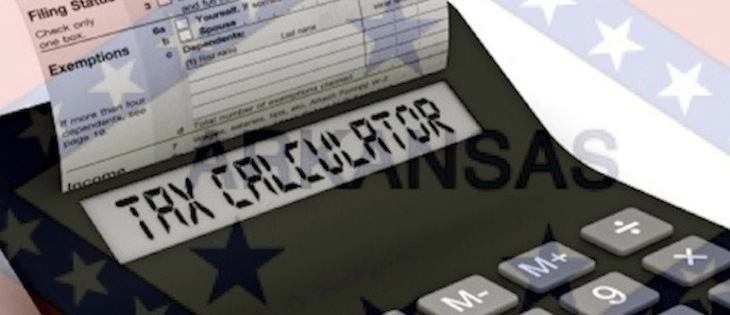Arkansas tax collections $5.1 million below forecast, four months left in fiscal year
by March 4, 2019 4:42 pm 571 views

Arkansas tax collections fell short of expectations in February due to thousands of federal employees across the state impacted by the partial government shutdown last month, state budget officials said Monday (March 4).
February net available revenues were $321.5 million, down 2.6% or $8.1 million from a year ago, and $9 million or 2.37% below forecast, according to the monthly revenue summary from the state Department of Finance and Administration (DF&A). February gross collections, a broader economic indicator that includes collections from all available categories, increased incrementally by 0.3%, or $1.2 million, to $459.1 million from a year ago, yet fell 3.4% or $16.2 million below forecast.
Eight months through fiscal year 2019 that began July 1, 2018, Arkansas’ coffers now total net available general revenues of $3.73 billion, which is $142.1 million, or 4% ahead of year ago levels and $5.1 million or just 0.1% below the state’s official forecast. Yearly gross general collections increased by $113.4 million, or 2.7%, to $4.34 billion compared with the same period of fiscal 2018 and $8.2 million, or 0.2%, above the revised general forecast.
According to DF&A economist John Shelnutt, state officials believe about 3,000 federal employees were impacted in the state, not counting the unaffected positions with enacted appropriations. President Donald Trump on Jan. 25 delayed his month-long insistence for $5.7 billion in border wall funding and agreed to a spending bill that would end the federal government shutdown until Feb. 8.
“We think there was some short-term, negative impact from the federal government shutdown in February collections,” said Shelnutt. “This was from a combination of skips in payroll withholding during January without complete compensatory recovery from the various federal agency payroll systems in time to even out the impact in the January-February revenue collection period.”
Shelnutt also noted that February is the lowest month of the year for state cashflows due to the start of high refund payouts for the income tax filing season combined with a short collection month and weak consumer spending after the Christmas holiday season. Overall, payroll withholding tax collections were up year-over-year by 3% but the forecast factored in higher growth to account for payday timing differences with the year ago period, not the government shutdown, said Shelnutt.
“The result was $9.1 million below forecast in that category alone,” said the DFA forecaster. “We also think there was a negative impact in consumer spending in January activity related to the shutdown and potentially from general uncertainty among consumers from stock market volatility and the shutdown.”
After seeing robust tax collections for the first six months of the state’s fiscal year, collections swooned for the second straight month since lawmakers have gathered in Little Rock for the 92nd General Assembly that began on Jan. 14. Last month, actual tax collections in January declined 30.4% below year ago levels in individual estimated tax payments versus the expected 15% decline in the forecast. That resulted in estimated tax payments coming in $17.6 million below forecast in January, when Arkansas and other states saw a dramatic decline in income tax collections due to extraordinary payments in January 2017 ahead of the Federal Tax Cuts and Jobs Act (TCJA) by high-income taxpayers and a sharp reduction in estimated payments.
Among the major categories, individual income tax collections in February increased by $4.8 million, or 2.1%, to $236.6 million compared to a year ago, which is $11.1 million, or 4.5% below forecast. Year-to-date individual income tax collections were up 1% or $20 million to $2.09 billion, which is $33.5 million or 1.6% below forecast.
Sales and use tax collections in January were $185.5 million, a decline of $8 million or 2.5% below year ago levels and $6.6 million or 3.4% below the state’s forecast. Year-to-date, sales and use tax revenue is up 2.9% at nearly $1.64 billion, which is $45.8 million ahead of last year and $16.2 million, or 1%, below forecast.
On the Senate floor, Sen. Larry Teague, D-Nashville, chair of the Joint Budget Committee, highlighted the February revenue and warned fellow lawmakers that they may get some questions on why tax collections came in below forecast.
“They are blaming it on the federal freeze shutdown, but they think it will correct itself,” Teague said at the end of Monday’s two-hour Senate chamber agenda.
The highly-watched monthly revenue report for Arkansas state government is among several state and federal economic indicators that have cast blame on the federal shutdown for lukewarm or declining trends. Last week, the U.S. Bureau of Economic Analysis (BEA) reported that the nation’s economy in the fourth quarter grew at its slowest pace since the first three months of 2018 as consumer and business spending pushed real GDP growth to a level of $20.89 trillion.
According to the BEA’s “initial” estimate, real U.S. gross domestic product (GDP) in the fourth quarter grew at a rate of 2.6%, down from the revised growth of 3.4% in the third quarter. Together with GDP growth of 3.4% and 2.6% growth in the third and fourth quarter respectively, U.S. economic output for the year averaged 2.9%, BEA data shows. In 2017, the nation’s economy grew at an annual rate of only 2.2%. A survey of top U.S. economists had forecasted GDP growth of 3.1% in 2018 and 2.3% GDP growth in 2019, according to the Wall Street Journal Economic Forecast Survey.
OTHER TAX REVENUE SOURCES
Alcoholic beverages
July-February 2019: $37.7 million
July-February 2018: $36.8 million
Games of skill
July-February 2019: $43.9 million
July-February 2018: $40.8million
Tobacco
July-February 2019: $143.1 million
July-February 2018: $145.5 million
Insurance
July-February 2019: $46 million
July-February 2018: $45.2 million
